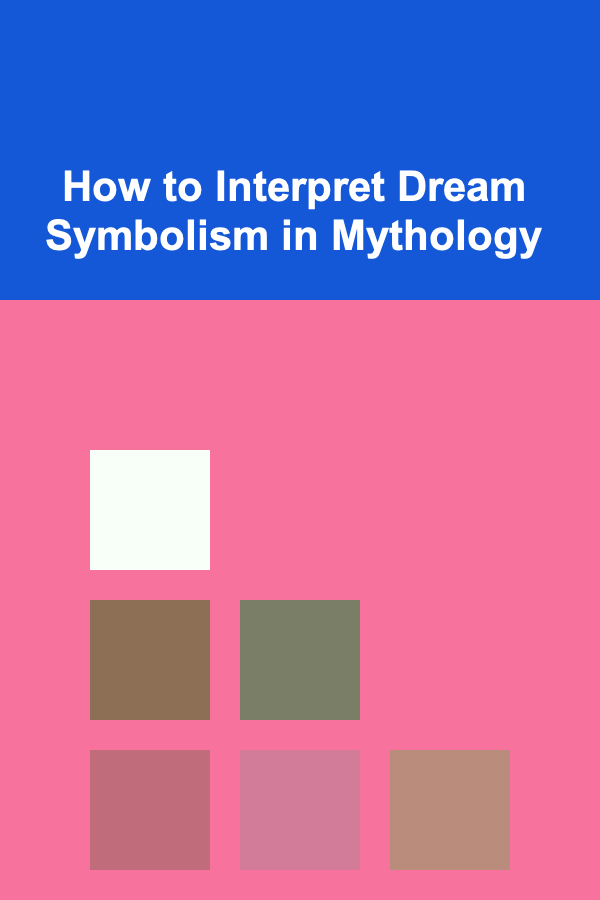
How to Interpret Dream Symbolism in Mythology
ebook include PDF & Audio bundle (Micro Guide)
$12.99$10.99
Limited Time Offer! Order within the next:

Dreams have long been a subject of fascination, often viewed as mysterious and cryptic glimpses into the unconscious mind. For centuries, humans have sought to understand the meaning of their dreams, turning to a range of cultural and spiritual frameworks to interpret them. One of the most enduring sources of dream symbolism comes from mythology. Throughout history, mythologies from around the world have provided rich symbolism that is deeply embedded in the human psyche, offering a unique lens through which we can interpret dreams.
In this article, we will explore how to interpret dream symbolism in mythology, delving into various mythological traditions and examining how symbols, gods, and archetypes can inform our understanding of dreams. We will cover the historical context of dream symbolism in myth, look at key mythological motifs that appear in dreams, and provide a practical framework for interpreting dreams using mythological symbolism.
The Role of Mythology in Understanding Dreams
Dreams are often seen as expressions of the unconscious mind, revealing hidden desires, fears, and emotions that may be suppressed during waking life. While dreams may be personal and subjective, the symbols that appear in them often resonate with universal themes, emotions, and experiences. Mythology, as a system of stories that explain the origins and workings of the world, has been a primary means through which different cultures have tried to explain human nature and the deeper workings of the psyche.
Mythological symbols, often drawn from gods, creatures, and mythical landscapes, can be potent tools for dream interpretation because they tap into deep-seated cultural archetypes. These archetypes, described by Carl Jung in his theory of the collective unconscious, are shared symbols and motifs that transcend individual experiences. By understanding these myths and their symbols, we can gain insight into our dreams and the messages they convey.
The Historical Context of Dream Interpretation
The interpretation of dreams in the context of mythology dates back to ancient civilizations. In many cultures, dreams were considered messages from the divine, portals to the spirit world, or even predictions of future events. The ancient Egyptians, for example, believed that dreams were communications from the gods, and they had professional dream interpreters who would decode these messages. Similarly, in ancient Greece, dreams were seen as omens or prophecies, with the god Asclepius often associated with healing through dreams.
One of the earliest recorded systems of dream interpretation comes from the Epic of Gilgamesh, where dreams are depicted as symbolic messages from the gods, guiding the hero on his journey. This approach to dream interpretation, which is common in mythological traditions, sees dreams not just as random occurrences, but as meaningful, often divinely inspired, experiences that help guide individuals through life's challenges.
Common Mythological Symbols in Dreams
Dream symbolism in mythology is rich with images and motifs that have stood the test of time across cultures. These symbols often represent fundamental human experiences, emotions, and archetypes that are relevant across different historical periods. Let's take a look at some of the most common mythological symbols that may appear in dreams.
Gods and Goddesses
Gods and goddesses are central figures in many mythologies and often appear in dreams as symbols of power, protection, guidance, or transformation. The specific nature of the god or goddess in the dream can offer clues about the underlying themes of the dream.
- Zeus/Jupiter (Greek/Roman Mythology): The king of the gods is often associated with authority, control, and justice. Dreaming of Zeus may indicate a need for greater control over one's life or a call for justice in an unjust situation.
- Athena/Minerva (Greek/Roman Mythology): As the goddess of wisdom and warfare, Athena represents intellect, strategy, and the balance between reason and action. Dreams of Athena may suggest that the dreamer is in need of wisdom or guidance in a difficult situation.
- Hecate (Greek Mythology): The goddess of magic, crossroads, and the moon, Hecate is often associated with transformation, intuition, and the liminal spaces between the known and the unknown. A dream of Hecate may signify a time of personal transformation or the need to trust one's intuition.
Animals and Mythological Creatures
Animals often carry deep symbolic meanings in both mythology and dreams. Mythological creatures such as griffins, phoenixes, and dragons represent powerful forces of nature or human traits. Dreaming of these creatures may suggest that the dreamer is grappling with inner forces or external challenges.
- Dragons (Across Cultures): The dragon is a potent symbol of power, fear, and transformation. In Eastern mythology, dragons represent benevolent, wise forces, while in Western cultures, they are often associated with danger and chaos. A dragon in a dream might symbolize a great challenge or an overwhelming force that the dreamer must face or overcome.
- Phoenix (Greek and Egyptian Mythology): The phoenix is a symbol of rebirth, immortality, and transformation. A dream involving a phoenix often signifies a time of renewal or personal growth after a period of difficulty or death of the old self.
- Crows/Ravens (Celtic and Norse Mythology): In many traditions, crows and ravens are associated with death, prophecy, and transformation. In Norse mythology, ravens are the companions of Odin, the all-knowing god. Dreaming of these birds might indicate that a significant change is on the horizon or that the dreamer needs to pay attention to a hidden truth.
Archetypal Figures
In mythology, there are many recurring archetypal figures that represent fundamental aspects of the human experience. These archetypes appear not only in myths but also in dreams, serving as powerful symbols of inner conflicts, desires, and potentials.
- The Hero: The hero's journey, a concept popularized by Joseph Campbell, is a central motif in many myths and often mirrors the process of personal growth and self-discovery. Dreaming of a heroic figure may indicate that the dreamer is undergoing, or about to undergo, a personal journey or transformation.
- The Shadow: In Jungian psychology, the shadow represents the unconscious aspects of the self, often those that are repressed or denied. In mythological terms, the shadow is represented by figures such as the trickster or the antagonist. A dream involving a shadow figure might indicate a confrontation with aspects of the self that have been ignored or suppressed.
- The Trickster: The trickster is a figure who challenges the status quo, often through mischief or deception. In mythology, figures like Loki in Norse mythology or Hermes in Greek mythology embody the trickster archetype. A dream featuring a trickster may suggest that the dreamer is being called to break free from convention or to see the world in a new, unconventional way.
Practical Framework for Interpreting Dream Symbols in Mythology
Now that we have examined some of the key mythological symbols that may appear in dreams, let's discuss how to practically interpret these symbols. While the process of dream interpretation is subjective and may vary from person to person, there are several steps that can help guide the analysis of dream symbolism through the lens of mythology.
1. Record the Dream
The first step in interpreting a dream is to record it as accurately and thoroughly as possible. Write down every detail of the dream, including the symbols, people, animals, and any significant actions or events. Pay particular attention to how you felt during the dream and upon waking, as emotions can often reveal important insights into the meaning of the symbols.
2. Identify the Key Symbols
Once the dream is recorded, identify the key symbols and mythological figures that stand out. This might include gods, animals, mythical creatures, or other archetypal figures. Focus on the most significant elements of the dream, such as the presence of a specific deity or a powerful animal.
3. Research the Mythological Significance
After identifying the key symbols, research their mythological significance. Look up the gods, goddesses, creatures, or archetypes that appear in the dream and learn about their roles in mythology. Consider the qualities associated with each figure and how they might relate to your current life situation.
4. Connect the Symbols to Your Personal Life
Reflect on how the mythological symbols in the dream might relate to your personal life. Are you facing a challenge that requires wisdom or strength? Are you undergoing a period of transformation or rebirth? Does the dream suggest the need for change or a deeper understanding of yourself? Consider the emotions you experienced in the dream and how they might reflect your current inner state.
5. Look for Patterns
Dreams often contain recurring patterns or themes. If you've had multiple dreams with similar mythological symbols, consider whether these dreams are trying to convey a consistent message. Patterns can often provide a clearer understanding of the deeper meaning behind the symbols.
Conclusion
Interpreting dream symbolism through the lens of mythology offers a rich and insightful way to understand the unconscious messages contained within our dreams. By exploring the archetypal figures, gods, and creatures from mythological traditions, we can uncover profound insights into our psychological and emotional states. Mythology provides a universal language of symbols that transcends culture and time, offering a powerful framework for understanding the deeper layers of the human experience. Whether through the wisdom of Athena or the transformation of the phoenix, mythology provides timeless tools for unlocking the mysteries of the dream world.

Best Organization Tools for Music and Audio Projects
Read More
How to Avoid Common Scams in the Data Entry Industry
Read More
How to Plan a Mindful Weekend Retreat at Home
Read More
How to Sell Your Rare Vinyl Records Online: A Comprehensive Guide
Read More
How to Use Deep Learning to Automate Your Way to Passive Income
Read More
How to Analyze System Logs with ELK Stack
Read MoreOther Products

Best Organization Tools for Music and Audio Projects
Read More
How to Avoid Common Scams in the Data Entry Industry
Read More
How to Plan a Mindful Weekend Retreat at Home
Read More
How to Sell Your Rare Vinyl Records Online: A Comprehensive Guide
Read More
How to Use Deep Learning to Automate Your Way to Passive Income
Read More